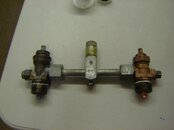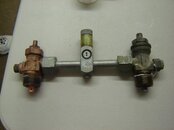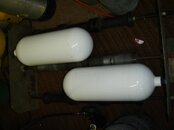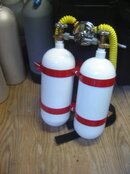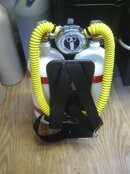You are using an out of date browser. It may not display this or other websites correctly.
You should upgrade or use an alternative browser.
You should upgrade or use an alternative browser.
More Vintage
- Thread starter Lone Frogman
- Start date
Please register or login
Welcome to ScubaBoard, the world's largest scuba diving community. Registration is not required to read the forums, but we encourage you to join. Joining has its benefits and enables you to participate in the discussions.
Benefits of registering include
- Ability to post and comment on topics and discussions.
- A Free photo gallery to share your dive photos with the world.
- You can make this box go away
Gilldiver
Contributor
The center section is original SCUBA and there is nothing to change out. But the post look like old CGA tank valves and were not for SCUBA.
It looks to be a DYI home made job.
It looks to be a DYI home made job.
I would like to get into the J valve to clean. Are there any o rings or seals that would need replacing? I think the tanks were originally used for oxygen. I stripped off five differant colors last being green before having them repainted. One of the post has oxygen stamped on it. It may be homemade, the tanks were made in 1943 with the last hydro in 1964. They passed hydro again last month.
Attachments
Gilldiver
Contributor
You don't have a J-valve on the manifold pictured. (I do want to correct myself; there is a seat on the center section, what type of seat you will find depends on who made it. It may be hard to find a replacement seat)
A standard J-valve will have 1 to 2 O-rings depending on the make. If the design is one that is accessed from under the on/off knob, then there should be a bonnet under the knob that will screw off. There is usually an O-ring sealing the bonnet and a 2nd O-ring sealing the knob shaft to the ID of the bonnet. An older UDS manifold with a J-valve may have a parts that are accessed from the other side after disassembly of the manifold using an allen wrench .
Inside of the J-valve is a spring loaded seat with a Mechanism to pull it away from the seating orifice. When the J-valve is UP, the spring hold the seat against the orifice and tank pressure pushes the seat open. The seat will not seal until the tank pressure falls to a lower pressure. Depending on the spring, this will be in the 300-500 psi range.
When the When the J-valve is Down, the seat is pulled away from the orifice and you have access to the remaining air.
Now with doubles, remember that the J-valve only works on one tank. By the time you have reach the hard breathing and turned the J-valve, the other tank will be at about 100-150 psi depending on how your reg works and what the IP is set at. If you are using a single stage like a Mistral, the other tank could be down to the water pressure.
In other words, the J-valve on a set of doubles will give you the exact same reserve volume of air as a J-valve on a single tank of the same size.
A standard J-valve will have 1 to 2 O-rings depending on the make. If the design is one that is accessed from under the on/off knob, then there should be a bonnet under the knob that will screw off. There is usually an O-ring sealing the bonnet and a 2nd O-ring sealing the knob shaft to the ID of the bonnet. An older UDS manifold with a J-valve may have a parts that are accessed from the other side after disassembly of the manifold using an allen wrench .
Inside of the J-valve is a spring loaded seat with a Mechanism to pull it away from the seating orifice. When the J-valve is UP, the spring hold the seat against the orifice and tank pressure pushes the seat open. The seat will not seal until the tank pressure falls to a lower pressure. Depending on the spring, this will be in the 300-500 psi range.
When the When the J-valve is Down, the seat is pulled away from the orifice and you have access to the remaining air.
Now with doubles, remember that the J-valve only works on one tank. By the time you have reach the hard breathing and turned the J-valve, the other tank will be at about 100-150 psi depending on how your reg works and what the IP is set at. If you are using a single stage like a Mistral, the other tank could be down to the water pressure.
In other words, the J-valve on a set of doubles will give you the exact same reserve volume of air as a J-valve on a single tank of the same size.
captain
Contributor
What you have is a home made manifold using two military surplus oxygen cylinders and valves connected together with a center section from a scuba manifold. If the valves operate and don't leak just use them as is. They won't kill you, a small leak is the worst that can happen.
The tanks have 1" taper pipe thread and you won't find a scuba manifold that will fit without a bushing adapter. The easiest is using two 1" to 1/2" high pressure pipe reducing bushing and a early 1/2" taper pipe thread scuba manifold.
In both cases, using either what you have or what I suggested the big problem is finding a shop willing to fill them. Either you have to have a compressor or use a transfill whip to fill them from other scuba cylinders or be in real tight with a shop owner who has knowledge of these old setups. I have a friend with a similar setup and he uses a transfill whip.
The tanks have 1" taper pipe thread and you won't find a scuba manifold that will fit without a bushing adapter. The easiest is using two 1" to 1/2" high pressure pipe reducing bushing and a early 1/2" taper pipe thread scuba manifold.
In both cases, using either what you have or what I suggested the big problem is finding a shop willing to fill them. Either you have to have a compressor or use a transfill whip to fill them from other scuba cylinders or be in real tight with a shop owner who has knowledge of these old setups. I have a friend with a similar setup and he uses a transfill whip.
Finished project and dive tested. 
Well the valves were in good condition till I tried to clean them in the ultra sonic cleaner. As most of you probably knew and I know now the ultra sonic cleaner destroyed the brass valves. Found new ones at my welding supply. The center part of the manifold is made by US Divers 1956 and the reserve works, no leaks. I mounted the tanks to a old Healthways BP.
Diving with these tanks on my back is like swimming with nothing. 4lbs of weigh with 3/2m shorty or no weights with bathing suit. Trim as good as it gets. I plan on filling off another tank, I have my VIP stickers but I don't want anything stuck on my tanks at least till I scratch the tanks up. And like the captain said no one would want to fill them anyway.
Well the valves were in good condition till I tried to clean them in the ultra sonic cleaner. As most of you probably knew and I know now the ultra sonic cleaner destroyed the brass valves. Found new ones at my welding supply. The center part of the manifold is made by US Divers 1956 and the reserve works, no leaks. I mounted the tanks to a old Healthways BP.
Diving with these tanks on my back is like swimming with nothing. 4lbs of weigh with 3/2m shorty or no weights with bathing suit. Trim as good as it gets. I plan on filling off another tank, I have my VIP stickers but I don't want anything stuck on my tanks at least till I scratch the tanks up. And like the captain said no one would want to fill them anyway.
Attachments
vintagediver
Contributor
Very nice...
Nice looking.
I think the reserve on the manifold is what was called an R reserve, not the common J valve.
The difference being that this has a restrictive orifice that will limit flow as pressure drops. The difference with the J valve is that the spring loaded reserve in a J will retract when you activate the lever and you will have access to the rest of the air supply. With the R type of valve you have to reduce your ambient pressure (go towards the surface) to access the available air. The amount of reserve air is also very limited.
This type of reserves were only around for a short period (long before my time), therefore I recommend you look into Basic Scuba by Roberts to confirm what I wrote.
I think the reserve on the manifold is what was called an R reserve, not the common J valve.
The difference being that this has a restrictive orifice that will limit flow as pressure drops. The difference with the J valve is that the spring loaded reserve in a J will retract when you activate the lever and you will have access to the rest of the air supply. With the R type of valve you have to reduce your ambient pressure (go towards the surface) to access the available air. The amount of reserve air is also very limited.
This type of reserves were only around for a short period (long before my time), therefore I recommend you look into Basic Scuba by Roberts to confirm what I wrote.
I knew I'd seen that valve in one of my books I just could not remember which book. Page 279 
Very nice setup. Have you considered modifying the bands so you don't need the backpack? Doubles can be very comfortable with no backpack.
c
c
Similar threads
- Replies
- 0
- Views
- 240
- Replies
- 50
- Views
- 4,218




